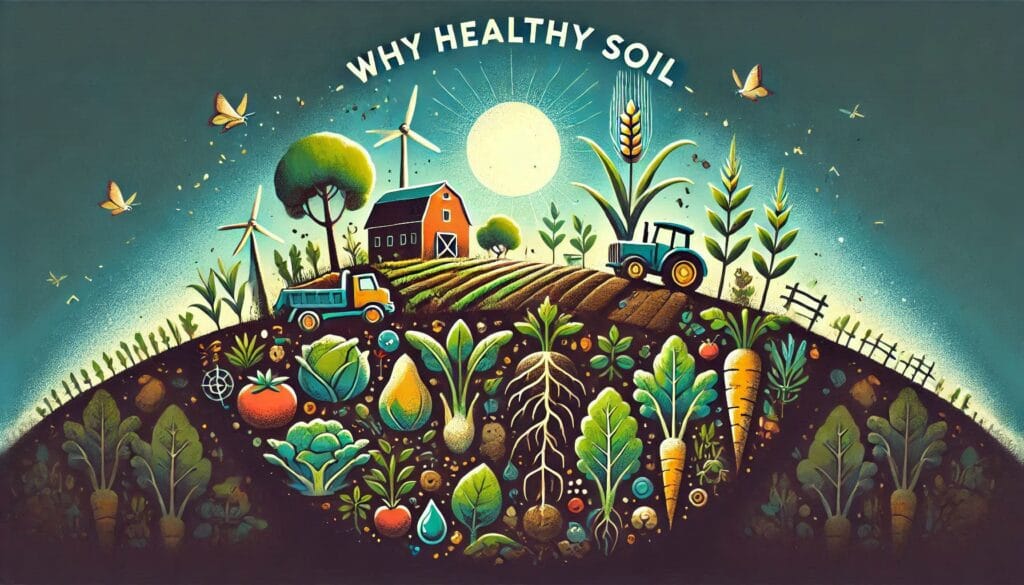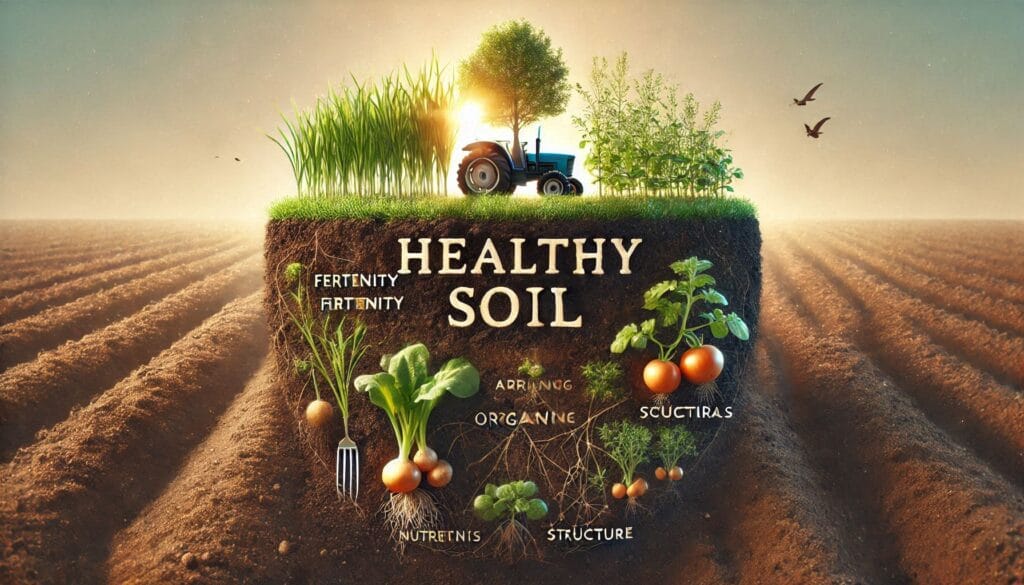Overview of the Importance of Soil Health
Soil health is the foundation of successful organic farming. A well-balanced soil ecosystem ensures sustainable crop growth, enhances biodiversity, and reduces the need for chemical fertilizers and pesticides. In this blog, we will explore the key aspects of soil health and why it is essential for organic farming.
Understanding Soil Composition: What Makes Up Healthy Soil? A Beginner’s Guide

Components of Healthy Soil
Healthy soil consists of a balanced mix of different components, each playing a crucial role in plant growth and soil fertility. These include:
- Sand – Provides good drainage but lacks nutrients.
- Silt – Retains moisture and nutrients better than sand.
- Clay – Holds nutrients well but can become compacted.
- Organic Matter – Improves soil structure, retains water, and provides nutrients.
- Microbes – Bacteria, fungi, and other microorganisms break down organic material and enhance nutrient availability.
The Role of Soil Components in Organic Farming
- Sand, Silt, and Clay Balance: The right balance ensures adequate drainage while retaining necessary moisture.
- Organic Matter Addition: Compost and cover crops help improve soil fertility and microbial activity.
- Microbial Activity: Beneficial microbes aid in nutrient cycling, suppress plant diseases, and promote healthy plant growth.
How to Assess and Improve Soil Health
- Soil Testing: Helps determine pH levels, nutrient deficiencies, and overall soil composition.
- Adding Organic Amendments: Compost, manure, and biochar enhance soil fertility.
- Crop Rotation and Cover Crops: Maintain soil structure and prevent depletion of nutrients.
- Minimal Tillage: Preserves soil life and reduces erosion.
Soil vs. Sand: Key Differences
- Soil: A complex mixture of minerals (sand, silt, clay), organic matter (decomposed plants/animals), water, air, and microorganisms.
- Sand: Primarily composed of mineral particles (e.g., quartz, feldspar) from weathered rocks, with little to no organic matter.
Particle Size:
- Sand: Largest soil particles (0.05–2 mm in diameter), gritty texture.
- Soil: Includes a range of particle sizes (sand, silt, clay). “Loam” refers to balanced mixtures ideal for plant growth.
Water Retention & Drainage:
- Sand: Drains water quickly due to large pore spaces. Poor nutrient retention.
- Soil: Retains moisture and nutrients better, especially if rich in clay or organic matter.
Uses:
- Sand: Used in construction, concrete, glassmaking, and coastal/dune ecosystems.
- Soil: Vital for agriculture, gardening, and supporting terrestrial ecosystems.
Ecological Role:
- Soil: Sustains plant life by providing nutrients, structure, and habitat for organisms.
- Sand: Supports specialized ecosystems (e.g., beaches, deserts) with organisms adapted to low-nutrient, dry conditions.
Formation:
- Sand: Results from mechanical/chemical weathering of rocks.
- Soil: Forms over time through weathering and the accumulation of organic matter.
Key Takeaway:
Sand is a component of soil but differs when considered in isolation. Soil’s organic content and mixed texture make it fertile, while sand’s mineral dominance suits structural or arid environments. Context matters—soil emphasizes fertility, while sand refers to a specific particle type or environment.
Conclusion
A deep understanding of soil composition is vital for organic farmers. By maintaining a healthy soil balance and enriching it naturally, farmers can ensure long-term sustainability and high-yield organic crops. Stay tuned for more insights on organic farming practices.

Why Is Soil Health Important to Food Production?
Soil health is essential for food production because it provides nutrients, water, and support for plant growth. Healthy soil enhances crop yield, improves food quality, and ensures long-term agricultural sustainability. Poor soil health leads to lower productivity, increased dependency on chemical fertilizers, and higher risks of crop failure.
Why Soil Health?
Soil health is vital for maintaining agricultural productivity, preserving the environment, and supporting biodiversity. It ensures efficient nutrient cycling, prevents erosion, retains moisture, and reduces the need for chemical inputs.
Why Is Soil Health Important?
Healthy soil contributes to food security, climate resilience, and ecosystem balance. It improves plant growth, enhances water infiltration, and sequesters carbon, helping mitigate climate change. Farmers, consumers, and the environment all benefit from maintaining soil fertility.
Who Benefits from Soil Health?
- Farmers: Increased productivity, lower input costs, and sustainable land use.
- Consumers: Better quality, nutrient-rich food.
- Environment: Reduced soil erosion, improved water conservation, and lower pollution.
- Future Generations: Sustainable agricultural practices ensure long-term food security.
Which Activities Improve Soil Health?
- Composting: Adds organic matter and enhances microbial activity.
- Crop Rotation: Prevents soil degradation and improves nutrient availability.
- Cover Cropping: Reduces erosion and enhances soil structure.
- Reduced Tillage: Preserves soil integrity and boosts microorganism activity.
- Organic Fertilizers: Provides essential nutrients naturally.
- Agroforestry: Combines trees and crops to improve soil stability and fertility.
When Was the Soil Health Card Scheme Launched?
The Soil Health Card (SHC) Scheme was launched by the Government of India on February 19, 2015. The scheme aims to assess soil quality and provide farmers with recommendations for nutrient management, helping them optimize fertilizer use and improve crop yields sustainably.
When Was the Soil Health Card Scheme Launched?
The Soil Health Card (SHC) Scheme was launched by the Government of India on February 19, 2015. It aims to provide farmers with detailed soil analysis reports and recommendations for balanced fertilizer use to enhance soil fertility and productivity.
When Soil Health Is Affected, What Happens to Biodiversity?
When soil health deteriorates, it negatively impacts biodiversity in several ways:
- Loss of Soil Microorganisms: Healthy soil contains beneficial bacteria, fungi, and earthworms that contribute to nutrient cycling. Degraded soil reduces their populations, disrupting ecosystem balance.
- Decline in Plant Diversity: Poor soil quality affects plant growth, leading to reduced food sources for herbivores and other wildlife.
- Increased Soil Erosion: Weak soil structure leads to erosion, washing away essential nutrients and affecting habitats.
- Reduced Water Retention: Unhealthy soil loses its ability to hold water, impacting aquatic ecosystems and plant survival.
- Higher Carbon Emissions: Degraded soil releases more carbon into the atmosphere, contributing to climate change and further harming biodiversity.
What Is Soil Health in Agriculture?
Soil health in agriculture refers to the soil’s ability to function as a living ecosystem that sustains plant, animal, and human life. It involves maintaining:
- Nutrient Balance: Sufficient levels of essential nutrients like nitrogen, phosphorus, and potassium.
- Soil Structure: Proper aeration and water retention for healthy root development.
- Biological Activity: Presence of beneficial microbes that help decompose organic matter and support plant growth.
- Minimal Contaminants: Avoiding excessive use of chemical fertilizers and pesticides to prevent soil degradation.
Healthy soil is fundamental for sustainable agriculture, ensuring long-term productivity and environmental conservation.




Thanks for sharing. I read many of your blog posts, cool, your blog is very good.